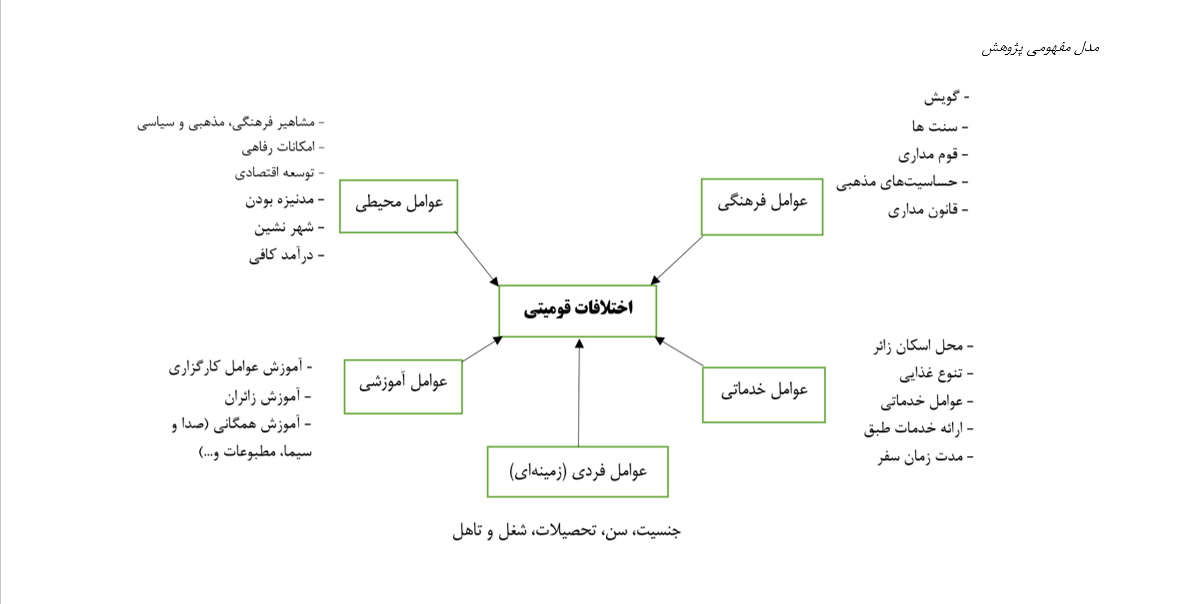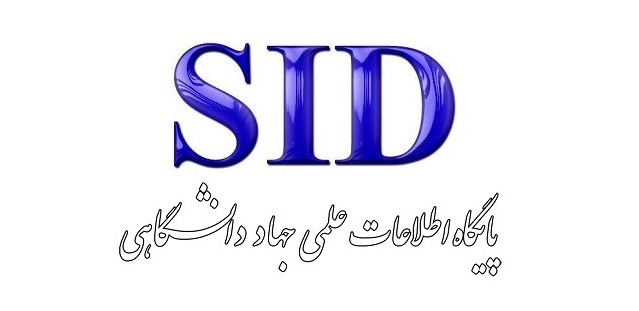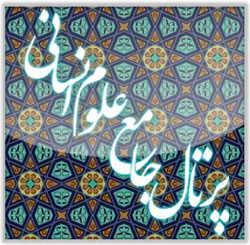بررسی عوامل اجتماعی موثر بر اختلافات قومیتی در سفرهای زیارتی (مطالعه موردی: زائران استان خراسان رضوی)
کلمات کلیدی:
اختلافات قومیتی, عوامل اجتماعی, زائر, کاروانچکیده
هدف پژوهش حاضر بررسی میزان اثرگذاری هر یک از عوامل اجتماعی بر اختلافات قومیتی در کاروانهای زیارتی استان خراسانرضوی است که جزء پژوهشهای کاربردی میباشد. جامعه آماری این پژوهش، زائران کاروانهای حج تمتع، عمره و عتبات عالیات استان خراسانرضوی است که طی سالهای 1392 تا پایان سال 1401 اعزام شدهاند. برای تعیین میزان نمونه تحقیق از فرمول کوکران استفاده شده که تعداد 384 نفر از زائران میباشند. روش جمعآوری اطلاعات مورد نیاز برای این پژوهش به صورت روش میدانی یعنی مراجعه به اسناد و مدارک، کتب، سایتها و پایگاههای داده معتبر اعم از فارسی و انگلیسی و سپس با استفاده از مبانی نظری و شاخصهای ارائه شده به تدوین پرسشنامه و توزیع آن بین جامعه هدف جهت سنجش میزان تاثیر عوامل اجتماعی بر اختلافات قومیتی پرداخته شده است. با استفاده از ضریب همبستگی و تحلیل رگرسیون، نوع و میزان ارتباط میان مفاهیم اصلی تحقیق مشخص میگردد که نتایج حاصله نشان میدهد به ترتیب؛ عوامل آموزشی، فردی (زمینهای)، فرهنگی، خدماتی، محیطی بر افزایش یا کاهش اختلافات قومیتی در میان زائران اثرگذار هستند. در این راستا یافتههای ناشی از تحلیل دادههای پژوهش نشاندهنده این واقعیت است که میزان اثرگذاری متغیرهای مستقل بر متغیر وابسته (اختلافات قومیتی) به ترتیب عوامل محیطی، عوامل فرهنگی، عوامل آموزشی، عوامل خدماتی و عوامل فردی (زمینهای) هستند و عوامل محیطی و فرهنگی با اختلاف زیاد نسبت به سایر عوامل بیشترین اثرگذاری را بر اختلافات قومیتی بین زائران کاروانهای زیارتی دارند. در میان مولفههای زیرگروه متغیرهای مستقل، مولفههای مربوط به محل زندگی زائران مانند امکانات رفاهی، توسعه اقتصادی، درآمد کافی، مدرنیزه بودن، شهرنشینی و مشاهیر فرهنگی، مذهبی و سیاسی، بیشترین و کمترین اثرگذاری را بر اختلافات قومیتی دارند که نشان میدهد؛ برخورداری شهروندان از امکانات مادی و اقتصادی به ویژه درآمد کافی در محیط زندگیشان، نقش موثری در کاهش اختلافات قومیتی در طول سفر زیارتی دارد و مولفههائی چون حساسیتهای مذهبی، سنتها، گویش، قوممداری و قانونمداری بر اختلافات قومیتی اثرگذارند که نشان میدهد؛ احترام به مقدسات، سنتها، آداب و رسوم و سایر ویژگیهای اقوام دیگر، در کاهش اختلافات قومیتی اثر محسوسی دارد. در این میان مولفههائی مانند آموزش نیروهای کارگزاری، آموزش زائران، آموزش همگانی (صداوسیما، مطبوعات و...)، موجب ارتقای سطح آگاهی زائران و افزایش تحمل و مدارای با همسفران است. مولفههائی مانند محل اسکان زائر، تنوع غذایی، نیروهای خدماتی، ارائه خدمات طبق قرارداد و مدت زمان سفر، محل اسکان، تغذیه، نیروهای خدماتی آموزش دیده، ارائه خدمات رفاهی بر اساس قرارداد سفر و مدیریت مدت زمان سفر به خصوص در سفرهای حج تمتع، موجب کاهش اختلافات قومیتی بین زائران میشود و نهایتاً مولفههای جنسیت، سن، تحصیلات، شغل و تاهل زائران نیز بر افزایش یا کاهش اختلافات قومیتی تاثیر دارند.
دانلودها
مراجع
Abdullah, A. M. (2016). Investigating the Amount of Attention to the Components of Ethnic and National Identity among Kurdish and Azeri Students in Tehran Universities. Quarterly Journal of Strategic Policy Research, 4(16), 39-64.
Ahmadi, H. (2016). Ethnicity and Ethnicism in Iran: Myth and Reality. Ney Publications.
Alavi, S. M. S. (2006). Theorizing the Position of Ethnicities in the Policy Making of the Islamic Republic of Iran, with Emphasis on Kurdish Ethnicity
Amir, A., Irvani, Z., & Hajiani, E. (2015). A Comparative Study of Ethnic Identity in Iran and Lebanon. Iranian Journal of Applied Sociology, 26(2), 1-15.
Beheshti, S. S., & Rastegar, Y. (2013). Sociological Explanation of Social Tolerance and Its Dimensions among Iranian Ethnicities. Journal of Iranian Social Issues, 4(2), 7-358.
Farahmand, M., & Najafi, K. (2018). Investigating the Factors Affecting Inter-Ethnic Conflicts of Lak and Lore in Khorramabad. Journal of Strategic Research on Security and Social Order, 7(1), 43-64.
Farid, A., Habibi, R., Ghasemzadeh, A., & Sepahi Shadbad, H. (2013). Investigating the Difference in Ethnic and Racial Prejudices of Students Based on Religious and Linguistic Orientations. Conference on Ethnicity and Culture of Islamic Iran,
Islami, A. (2006). Ethnicity and Its Dimensions in Iran. Journal of Political Science, 9(34), 195-212.
Jalai Pour, H., & Nazar Abbasi, S. (2012). Ethnic Nationalism and Factors Affecting It (Case Study: Turkmen Students of Golestan Province). Publications of Tehran University, 1(1), 119-143.
Lahsai, A., Moghadas, A. A., & Taghavi Nasab, S. M. (2009). Investigating the Internal Factors Affecting Ethnic Host and National Identity among Arabs in Ahvaz. Journal of Applied Sociology, 20(33), 49.
Maghsoudi, M. (2001). Ethnicities and Cultural Identity of Iran. Nameh Pazhoohesh(22 and 23).
Mirzaei, S. A., & Eidi, M. (2020). Nationalism, Ethnicity and Ethnicism; A Case Study of Bojnourd City. Bi-Quarterly Journal of Cultural Social Research, 11(1), 125-159.
Mohammadzadeh, H., & Khani, S. (2018). Historical and Social Contexts Affecting Ethnic Division in Iran. Journal of Iranian Social Studies, 12(3), 125-147.
Moradi, A., Kavosi, I., & Ghyoomi, A. (2015). Designing a Model of Cultural Synergy in Iran. Quarterly Journal of Strategic Studies of Globalization, 6(15), 225-271.
Nik Bakhsh, B., & Vahidi, A. (2023). Second National Conference on Social and Psychological Harms with Emphasis on Behavioral Sciences.
Omidi, A. (2008). Comparing Structural Models of Management of Ethnic Communities: Lessons for Iran. Bi-Quarterly Journal of Program and Budget(106), 65-100.
Omidzadeh, G., & Omidzadeh, H. (2011). Journal of Social Sciences, Faculty of Literature and Human Sciences, University of Mashhad. Journal of Social Sciences, Faculty of Literature and Human Sciences, University of Mashhad, 8, 103-133.
Parchami, D., & Derakhshan, F. (2021). Investigating Social Gaps and Factors Affecting It (Case Study: Tehran). Journal of Applied Sociology, 32(3), 1-26.
Ragheb Esfahani, H. b. M. (1991). Mufradat Alfaz al-Quran. Dar al-Qalam - Al-Dar Al-Shamiya.
Sambanis, N. (2000). Partition as a Solution to Ethnic War. World Politics(4).
Serajzadeh, S. H., & Adhami, J. (2008). Investigating Ethnic Differences of Students in Terms of Activity in Cultural Centers of Universities. Quarterly Journal of Cultural Research, 1(2), 135-158.
Shamsi, K., & Eisazadeh, K. (2016). Management Strategy of the Holy Prophet of Islam (PBUH) in Order to Strengthen Unity among Ethnicities in the Early Islam. Journal of Habl al-Matin, 5(14), 94-105.
Torabi, Y. (2009). Policies of the Islamic Republic in Managing Social Diversities. Journal of Political Science, 5(1), 115-157.
Umana - Taylor, A. J., & Gomez, B. M. (2004). Developing the Ethnic identity scale using Eriksonian and social Identity perspectives. IDENTITY : An International journal of theory and Reserch. https://doi.org/10.1207/S1532706XID0401_2
Yousefi, A. (2001). Inter-Ethnic Relations and Its Impact on the National Identity of Ethnicities in Iran: A Secondary Analysis of a National Survey. Quarterly Journal of National Studies, 2(8), 13-42.
Yousefi, A., & Asgharpour Masouleh, A. (2009). Ethnocentrism and Its Effect on Inter-Ethnic Relations in Iran. Journal of Social Sciences of Tarbiat Modares University(11).

دانلود
چاپ شده
ارسال
بازنگری
پذیرش
شماره
نوع مقاله
مجوز
حق نشر 2025 Ruhollah Shahebrahimi (Author); Manouchehr Pahlavan (Corresponding Author); Majedeh Gholipour (Author)

این پروژه تحت مجوز بین المللی Creative Commons Attribution-NonCommercial 4.0 می باشد.







